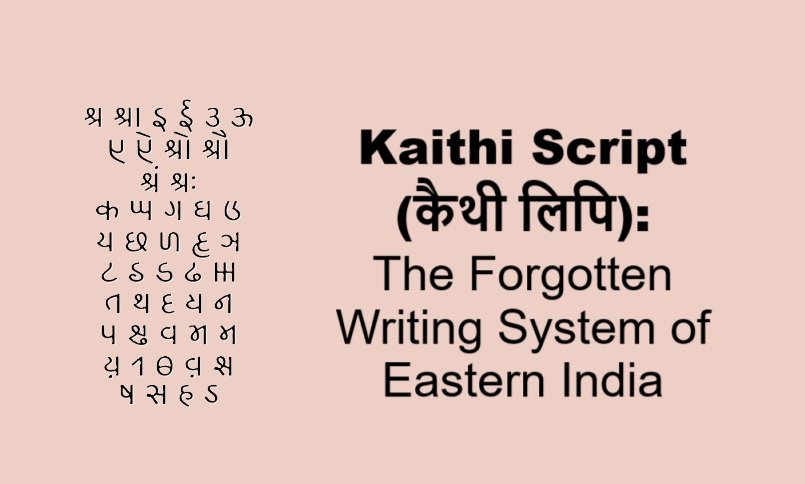
Introduction
The Kaithi script (कैथी लिपि) is a historic Brahmic writing system once extensively used in eastern India. Popular from the 16th to early 20th centuries, it was primarily used for writing regional languages such as Bhojpuri, Magahi, Maithili, and even early forms of Hindi and Urdu.
Despite its historical importance, Kaithi gradually faded from mainstream use and was largely replaced by Devanagari and Perso-Arabic scripts. Today, it stands as a symbol of India’s diverse linguistic and scriptural legacy.
Etymology and Origin of the Term “Kaithi”
The term Kaithi derives from the word “Kayastha”, a community of scribes and record keepers in North India. The Kayasthas used this script for writing legal documents, land records, personal correspondence, and business accounts.
Thus, the name Kaithi reflects its professional and administrative usage in the past.
Historical Context and Evolution
📍 Geographic Spread
Kaithi was widely used in:
- Bihar
- Uttar Pradesh
- Jharkhand
- Parts of Madhya Pradesh and Chhattisgarh
🕰️ Time Period
- Earliest mentions: 16th century
- Peak usage: 18th–19th century
- Decline: Post-1850s due to British administrative reforms
📚 Usage Domains
- Legal documents
- Land and revenue records
- Personal letters
- Religious literature (sometimes)
- Commercial transactions
Languages Written in Kaithi Script
Kaithi was a multilingual script, used to write:
- Bhojpuri
- Magahi
- Maithili
- Awadhi
- Angika
- Hindi (early forms)
- Urdu (limited usage)
Features and Characteristics of Kaithi Script
| Feature | Description |
|---|---|
| Script Type | Brahmic (abugida) |
| Writing Direction | Left to right |
| Shape | Cursive, flowing, less angular than Devanagari |
| Ligatures | Fewer than Devanagari, making it easier for clerical use |
| Diacritics | Used for vowel representation |
| Numerals | Indigenous numeral system used |
Visual Style
Kaithi was less ornamental than Devanagari. It was designed for fast writing, often using reed pens and ink, which gave it a flowing, cursive appearance suitable for record-keeping.
Decline of the Kaithi Script
Despite its widespread use, Kaithi began to decline during the British colonial period due to:
- Administrative Preference: The British chose Devanagari for Hindi and Perso-Arabic for Urdu in official documentation.
- Lack of Standardization: Kaithi had several regional variants, which made standardization difficult.
- Educational Reform: Schools began teaching Devanagari and Urdu instead of Kaithi.
- Print Technology: Typefaces and printing presses favored Devanagari and Urdu fonts.
By the early 20th century, Kaithi was virtually extinct as a living script.
Kaithi in the Digital Age
💻 Unicode Inclusion
Kaithi script was officially added to the Unicode Standard in 2009, under Unicode Block U+11080–U+110CF. This inclusion helps preserve the script in digital texts and allows academic study and digitization of ancient manuscripts.
🔠 Sample Unicode Characters
- 𑂀 – Kaithi Letter A
- 𑂁 – Kaithi Letter AA
- 𑂳 – Kaithi Vowel Sign AA
- 𑂩 – Kaithi Letter KA
You can explore the full Kaithi block here: Unicode Kaithi Chart
Manuscripts and Inscriptions
🏛️ Archival Evidence
Many historical documents in Kaithi are preserved in:
- Khuda Bakhsh Library, Patna
- Asiatic Society, Kolkata
- British Library, London
- National Archives of India
These documents include zamindari records, court proceedings, and merchant ledgers from the Mughal and British periods.
Relationship with Other Scripts
| Script | Relation |
|---|---|
| Devanagari | Shared Brahmic roots, more formal |
| Modi Script | Similar cursive script used in Maharashtra |
| Bangla | Both evolved from ancient Siddham and Nagari |
| Sharada/Takri | Other regional Brahmic scripts from North India |
Kaithi is unique for its cursive form and its association with record-keeping rather than religious texts, unlike Devanagari.
Modern Relevance & Revival Efforts
Although not in active daily use, Kaithi has garnered scholarly interest in recent decades.
🪶 Revival Initiatives:
- Academic Research: Linguists and historians are documenting Kaithi manuscripts.
- Digital Archiving: Libraries are digitizing old Kaithi documents.
- Unicode Integration: Enables revival in fonts, OCR, and script learning apps.
- Cultural Awareness: Kayastha and Maithil communities promote knowledge of the script in heritage events.
Conclusion: Why Kaithi Matters Today
The Kaithi script stands as a testament to India’s administrative and linguistic diversity. While it may no longer be in daily use, Kaithi’s historical role in shaping regional language expression and governance is invaluable.
As we advance toward digital preservation and decolonizing education, reviving knowledge about Kaithi is essential—not just for linguists but for anyone passionate about India’s multilingual heritage.







